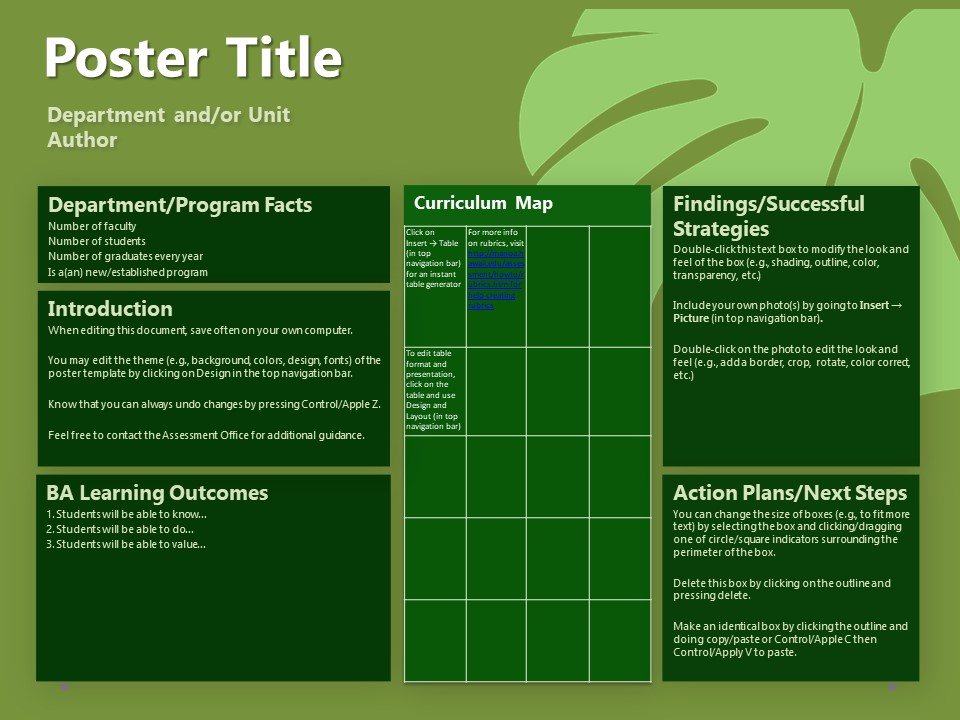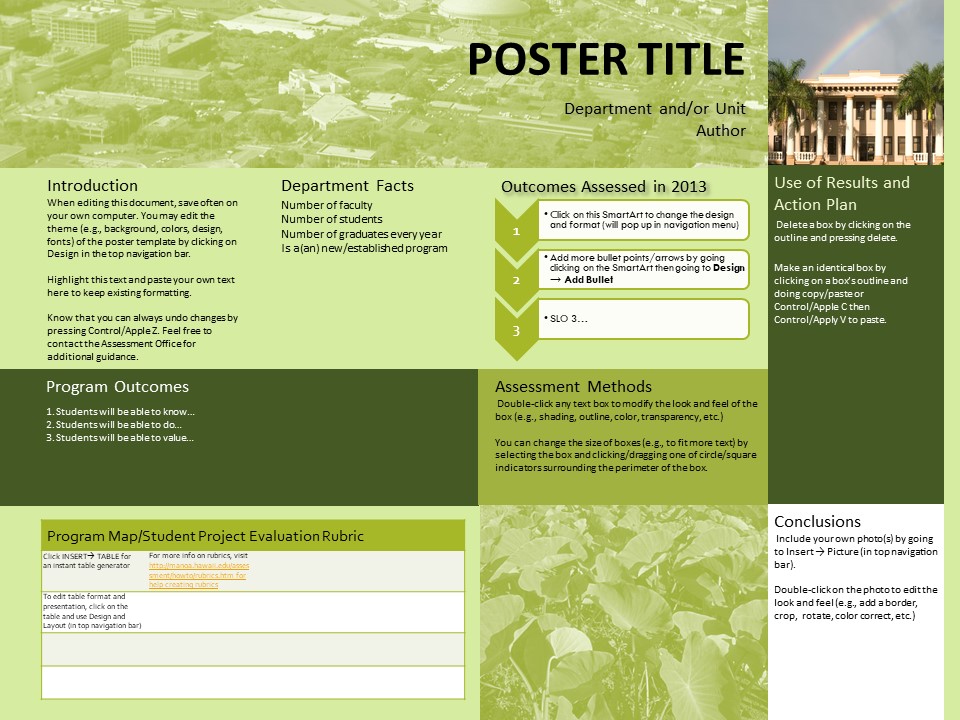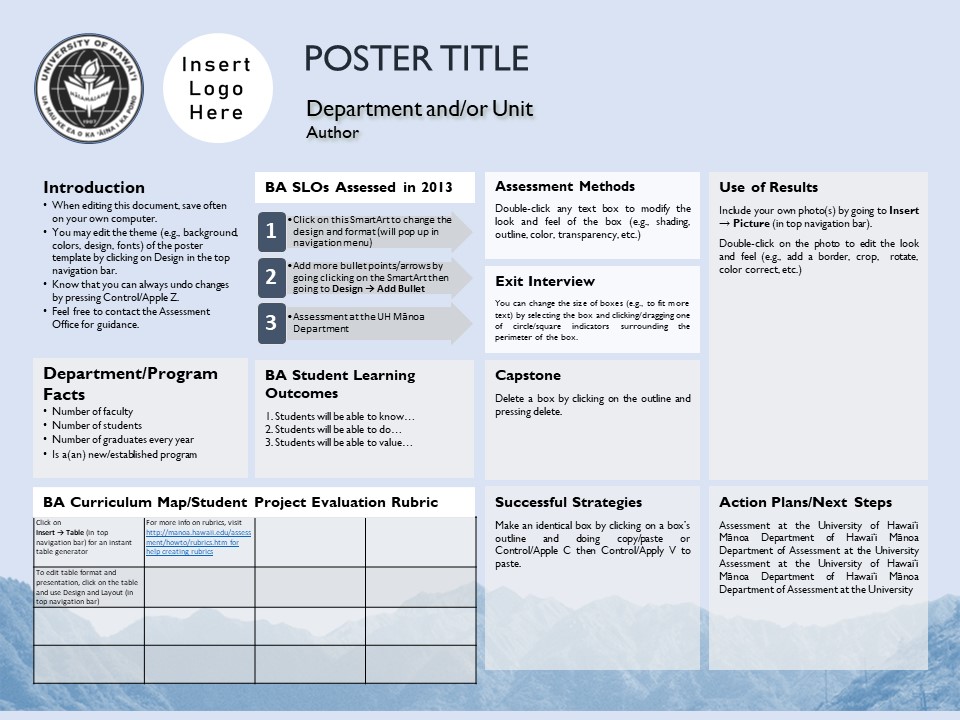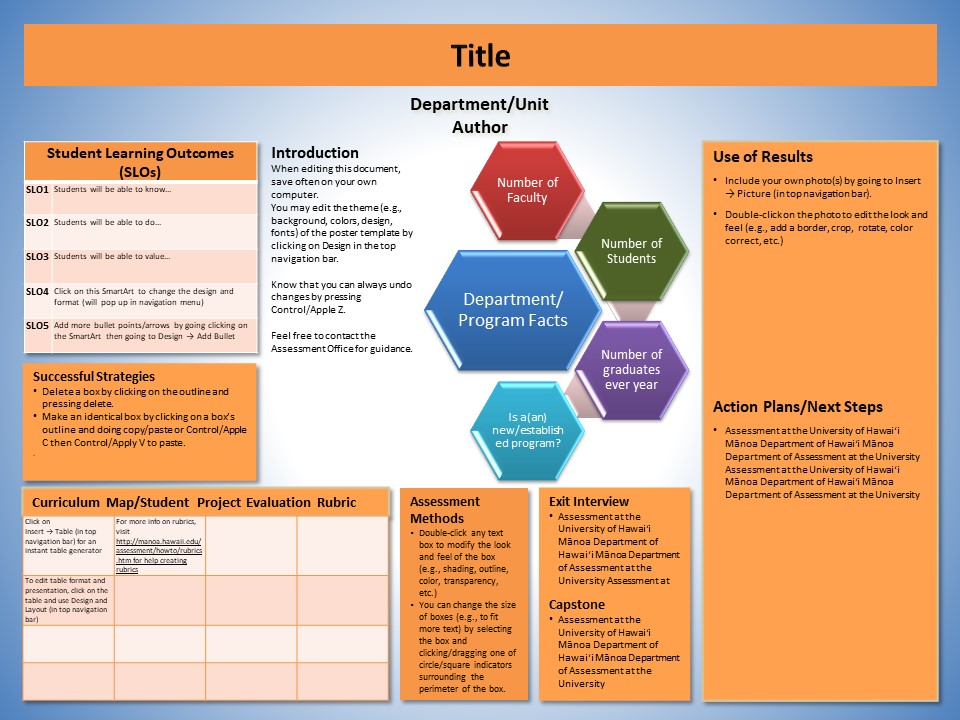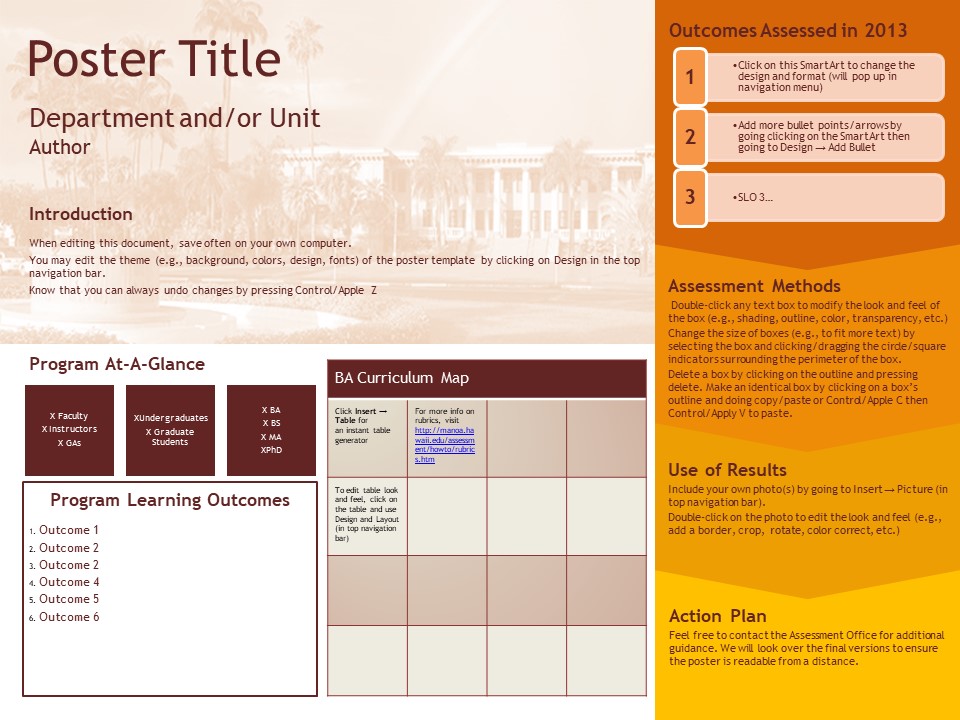April 1-5, 2024 – Online via Zoom
From Monday April 1st to Friday April 5th, 2024, the Assessment and Curriculum Support Center hosted 10th Assessment for Curricular Improvement Poster Exhibit. Attendees circulated through Zoom breakout rooms to visit with poster presenters and discuss program assessment for the purpose of improving student learning. The live Zoom session on Friday was the culminating event of this year’s exhibit.
The Assessment and Curriculum Support Center would like to thank everyone involved for being part of this year’s virtual event!
Poster Awards
Best Faculty Engagement:
- K. ʻAlohilani HN Okamura (School for Teacher Education/Secondary Program, University of Hawaiʻi at Mānoa): E Ulu Aʻe
- Brett Oppegaard (School of Communication and Information, University of Hawaiʻi at Mānoa): Journalism Foundations
- Chanda Deaton & Julie Saam (Center for Teaching, Learning, and Assessment, Indiana University Kokomo): Remodel, Rebuild, Redesign: Rewriting our story for Co-curricular Assessment
- Kamakanaokealoha Aquino & Tiare Sabellano-Tsutsui (Hui ʻĀina Pilipili, Social Sciences Dean’s Office, University of Hawaii at Mānoa): Strengthen Ea Hawaiʻi within Social Science: An Assessment of Student Experiences
- Lorrie Wong (Nancy Atmospera-Walch School of Nursing/Nursing, University of Hawaii at Mānoa): Transforming Nursing Education – AACN Essentials 2021
Best Use of Assessment for Improvement:
- K. ʻAlohilani HN Okamura (School for Teacher Education/Secondary Program, University of Hawaiʻi at Mānoa): E Ulu Aʻe
- Brett Oppegaard (School of Communication and Information, University of Hawaiʻi at Mānoa): Journalism Foundations
- Kamakanaokealoha Aquino & Tiare Sabellano-Tsutsui (Hui ʻĀina Pilipili, Social Sciences Dean’s Office, University of Hawaii at Mānoa): Strengthen Ea Hawaiʻi within Social Science: An Assessment of Student Experiences
- Lorrie Wong (Nancy Atmospera-Walch School of Nursing/Nursing, University of Hawaii at Mānoa): Transforming Nursing Education – AACN Essentials 2021
Best Poster Design:
- Amy Fuller & Jill Denhardt (Chemistry, University of Hawaii at Mānoa): Kukui Nut Calorimetry, Place-Based Learning in General Chemistry Lab at the University of Hawaii at Manoa
- Kamakanaokealoha Aquino & Tiare Sabellano-Tsutsui (Hui ʻĀina Pilipili, Social Sciences Dean’s Office, University of Hawaii at Mānoa): Strengthen Ea Hawaiʻi within Social Science: An Assessment of Student Experiences
Posters at the 2024 Exhibit
Aquino, Kamakanaokealoha and Sabellano-Tsutsui, Tiare (Hui ʻĀina Pilipili, Social Sciences Dean’s Office, University of Hawaii at Mānoa): Strengthen Ea Hawaiʻi within Social Science: An Assessment of Student Experiences
Aytac, Gunes and Lozanoff, Scott (Anatomy, Biochemistry and Physiology, John A. Burns School of Medicine, University of Hawaii at Mānoa): Advancing Anatomy Education Through Data-Driven Curriculum Development
Brown, Shana, Foukouna, Joseph, Jolly, Karen, Komar, Bailey, and Totani, Yuma (History, University of Hawaii at Mānoa): A Curricular Intervention to Build History Research Skills
Beaule, Christine and Paradise, Rosalie (General Education Office, University of Hawaii at Mānoa): Assessment Approaches to Diversification in General Education at UH Manoa
Deaton, Chanda and Saam, Julie (Center for Teaching, Learning, and Assessment, Indiana University Kokomo): Remodel, Rebuild, Redesign: Rewriting our story for Co-curricular Assessment
Fuller, Amy and Denhardt, Jill (Chemistry, University of Hawaii at Mānoa): Kukui Nut Calorimetry, Place-Based Learning in General Chemistry Lab at the University of Hawaii at Manoa
George, Olivia (Mathematics, Natural and Health Sciences Division, University of Hawaii – West O’ahu): Assessing UH-West O’ahu Provisional Accreditation of the BS-Natural Sciences Program through Faculty Engagement and Rubric Analysis: Findings and Challenges
Joseph, Michiko and Spencer, Lisa (Library, University of Hawaii – West O’ahu): Are we, at UH West Oahu, meeting our Critical Thinking benchmark?
Lucas, Chris (College of Education, Department of Educational Administration, University of Hawaii at Mānoa): Wayfinding Our ‘North Stars’: Arriving at One Department’s Values and Vision
McDaniel, Valerie (Speech-Language Pathology, University of the Pacific): The Return to 100: Overcoming Perceived Student Barriers to Passing the Speech-Language Pathology Praxis
Okamura, K. ʻAlohilani HN (School for Teacher Education/Secondary Program, UH Mānoa): E Ulu Aʻe
Oppegaard, Brett (School of Communication and Information, University of Hawaii at Mānoa): Journalism Foundations
Reece, Joel and Bradshaw, Charles (Health & Human Services, English, Brigham Young University-Hawaii): Catching the Wave of Program Assessment
Rombaoa Tanaka, Naomi (Center on Disability Studies, University of Hawaii at Mānoa): Elevating Weekly Formative Assessment: Building Relationships with Students Through the Art of Active Constructive Responding
Shulga, Lenna, Berbekova, Adiyukh, and Seo, Kwanglim (School of Travel Industry Management, Shidler College of Business, University of Hawaii at Mānoa): Assessing Students’ Professional Readiness in MS-TIM Program
Walguarnery, Justin (School of Life Sciences, University of Hawaii at Mānoa): Assessing Cooperative Work in Life sciences Research
Wong, Lorrie (Nancy Atmospera-Walch School of Nursing/Nursing, University of Hawaii at Mānoa): Transforming Nursing Education – AACN Essentials 2021
Who attends the Poster Exhibit? Faculty, staff, and administrators interested in learning assessment for improvement.
Cost? No fee. Free to presenters and attendees.
Presenter Instructions and Help
Table of Contents
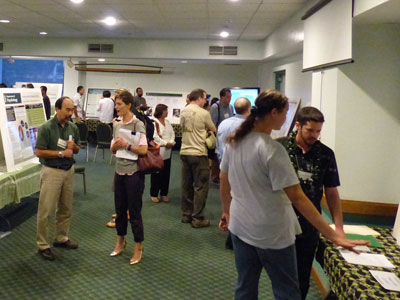
Templates
Please feel free to use the following letter-sized (11″ width x 8.5″ height) templates to create your virtual poster for online poster presentations (PowerPoint Slide/Google Slide).
Tips and Tools
- Strategies and Tutorials to Create Effective Posters and Presentations
- Suggested Poster Content
- Basic program information such as the number of faculty and students, degree(s) offered, and number of graduates per year
- Context of the assessment project: program learning assessment status/history of assessment in your program
- Description of the assessment project: useful tips, strategies, tools, steps in the process, end products, etc.
- Highlight how your program used assessment processes/findings for improvement
- Summary of accomplishments, lessons, strategies/tools to share
- Acknowledgements–assessment is a team sport
- Additional Content Considerations
- Have a clear theme and organization
- A program’s assessment efforts may include many accomplishments. Focus on a central theme/problem/project and organize the content to enhance the take-away message.
- Content is useful for audience
- Whenever possible, describe the processes, strategies, and tools that others may adapt/adopt. Attendees also appreciate knowing the challenges faced in the assessment project and (possible) solutions.
- Focus on assessment-for-improvement
- A primary goal of assessment is program and student learning improvement. Describe the action(s) that the program took in response to the assessment findings or challenges encountered (e.g., redesigning assignments, changing pre-requisites, refining advising practice, increasing faculty collaboration and collegiality).
- If possible, include the impact on student learning after the program took the action(s).
- Have a clear theme and organization
- Sample Topics and Past Presenters
- Use of assessment results for curricular improvement
- Curriculum mapping and its role in program assessment and improvement
- Development and use of a rubric for program assessment
- Capstone portfolio assessment for curricular improvement
- For more examples, see posters from the 2023 exhibit.
Evaluation Criteria
1. Poster Design Quality
| 4 | Exceptional. Exceptionally attractive in design, layout, and neatness. The design enhances the content and represents a clear flow of the content. The font size and typeface intentionally signal main and subordinate points/messages and are very easy to read. Graphics (if used) easily and quickly convey the meaning. |
| 3 | Proficient. Design, layout, and neatness help the viewer understand the content. The font size and typeface are appropriately sized for easy reading. Graphics (if used) convey the meaning, with the help of the text. |
| 2 | Developing. Design, layout, font are perfunctory and do not help or hinder the message. |
| 1 | Beginning. Design, layout, font hinder the message. For example, design is cluttered or illogical, layout is confusing, too much text, font size is too small to read. |
2. Use of Assessment for Improvement
| 4 | Exceptional. A group of faculty members (or other stakeholders) collaborated to use an assessment process or the assessment results directly and intentionally for the purpose of improvement (of student learning, the curriculum, resource allocation, policies, assessment processes themselves). They implemented the assessment process, engaged in critical reflection, and used the process and/or assessment results to logically inform changes. Bonus points to posters in which a follow-up assessment project was conducted to examine the effectiveness of the changes made. |
| 3 | Proficient. Assessment for improvement because the faculty (or other stakeholders) made changes that were informed by assessment processes and/or results. |
| 2 | Developing. The faculty (or other stakeholders) discussed possible actions but no clear action has been taken —OR— the faculty made changes but it’s not clear how the actions are tied to the assessment process/results. |
| 1 | Beginning. The project focuses on the assessment process or results itself without reflection/discussion/use of the process/results for improvement actions. |
3. Faculty Engagement Strategies
(a good assessment process is collaborative)
| 4 | Exceptional. The strategies to engage faculty (or other stakeholders) are really working. Faculty/stakeholders participate in assessment-related activities. They appear involved with an assessment-for-improvement process through their regular participation and ongoing attention to curriculum effectiveness and student learning at the program or institution level. |
| 3 | Proficient. Engagement strategies were used because faculty (or other stakeholders) did participate in at least one assessment-related activity aimed at the program/institution level. |
| 2 | Developing. The strategies appear to have engaged a few committed folks, but it’s unclear if participation is widespread and if faculty regularly attend to learning and curriculum development at the program/institution level as a result of the strategies. |
| 1 | Beginning. It seems to be a project primarily done by one person without participation/engagement from other faculty members. |
Best Practice Examples
For best practice examples, please also see the following 2023 poster exhibit award winners:
2023 Poster Awards
Best Poster Design (2-way tie):
- Kimberly U’ilani Chow-Rule (Nursing, University of Hawaiʻi at Mānoa): Ho’okaulike: Integrating Hawaiian Culture as an example of cultural safety in a nursing curriculum
- Thomas Quattlebaum & Cynthia Kim (Family Medicine and Community Health, University of Hawaiʻi at Mānoa): Look and Listen: Developing Faculty Competency in Direct Observation
Best Use of Assessment for Improvement (2-way tie):
- Aimee Chung & Wendy Lum (Social Work, University of Hawaiʻi at Mānoa): Assessment and the Competent Field Education Student: A Rubric for Learning Decolonized Social Work Practice
- Jennifer Griswold (Atmospheric Sciences, University of Hawaiʻi at Mānoa): Connecting Courses to Competency: Mapping the ATMO Curriculum
Best Faculty Engagement Strategies (2-way tie):
- Thomas Quattlebaum & Cynthia Kim (Family Medicine and Community Health, University of Hawaiʻi at Mānoa): Look and Listen: Developing Faculty Competency in Direct Observation
- Priscilla Sung (Institutional Research, Assessment, & Policy Studies, University of California, Santa Cruz): From Seedlings to Harvest: Successes and Challenges of a Grassroots Approach to Assessment
For additional examples, see all 2023 posters or view additional past posters in our archive by clicking here.


